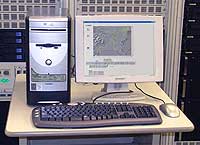|
|
|||||||
|
|
|||||||
|
|||||||
| | Web Japan >> | Trends in Japan >> | Science & Technology >> | Early Warning | |
|
EARLY WARNING Emergency System Would Alert People to Quake Threats (June 9, 2006) Recent technological advances mean that it may now be possible to warn people of an earthquake before the most destructive tremors strike. The Japan Meteorological Agency plans to begin offering emergency quake information directly to railway operators, fire departments, and other key institutions in the summer of 2006. Since the technology used in this system could also be used to lessen the damage to households - by cutting off gas supplies automatically to avoid fires, for example - a quake warning system for the general public is also being planned and could be ready by the spring of 2007. Every Second Counts A system that detects P waves and halts trains running in the area predicted to be struck by an earthquake was constructed and went into operation more than ten years ago. Looking to build on this achievement, the JMA and the Railway Technical Research Institute jointly developed a method for processing emergency earthquake warnings. The time differences involved are only a few seconds, but the JMA believes that if a system could be developed to use the information to cut gas and electricity supplies, damage to ordinary households could be reduced. Trials of the Earthquake Early Warning are already underway. The RTRI and Odakyu Electric Railway have developed a system to make use of the warnings on Odakyu's lines. When the Odakyu system receives information of a quake, it automatically estimates the amount of possible damage to the company's rail facilities. If damage is predicted, the system emits a warning ordering all trains to make an emergency stop, and drivers halt their trains manually. The system takes less than one second to process the quake-related data and issue the warning. Home Connection The system designed to alert ordinary households of an earthquake is called the IT Automatic Disaster Prevention System. Controllers installed in houses would use audio and text messages to warn householders of the timing and expected strength of an earthquake. The data would originate from the central server of the Japan Electronics and Information Technology Industries Association. The system could contribute to preventing fire and other secondary damage from large earthquakes by shutting off gas supplies, as well as enabling citizens to take cover. Yet there is also a risk that such a system could trigger mass panic among the population if its implementation is not properly thought out. The system's designers are working hard to minimize this risk. Most citizens appear to welcome the advent of such a warning system. A poll has shown that about 60% of people would be willing to have such a system installed in their homes, while around 80% expressed some degree of trust in the system. Copyright (c) 2006 Web Japan. Edited by Japan Echo Inc. based on domestic Japanese news sources. Articles presented here are offered for reference purposes and do not necessarily represent the policy or views of the Japanese Government. |
||
|




